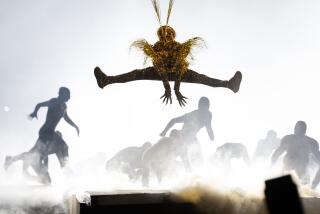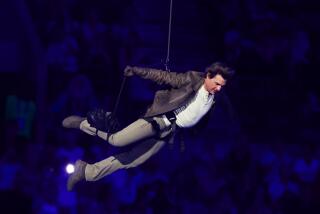Spectacle Makers
- Share via
TURIN, Italy — There’s a moment in tonight’s opening ceremony, a play on the notion of this city as the Detroit of Italy, that’s all but guaranteed to be a stunner. A tribute to Italy’s automotive heritage, it’s also part race against the clock, the seconds ticking down on scoreboards scattered around Olympic Stadium.
Marco Balich of Venice, Italy, a 43-year-old lawyer, turned rock promoter, turned Olympic ceremony producer, can hardly wait.
Passion, design, style, energy -- in just one take, the race against time underscores those elements of Italian life that Balich and associate producer Ric Birch sought to highlight in tonight’s ceremony, all guided by one principle: “Is this emotionally true to the culture?”
More than 33,000 people will crowd into the stadium tonight, and a television audience of more than 2 billion is expected to watch worldwide for the moment that, for many, is the essence of the Olympic Games.
For many of the athletes -- about 2,500 are here -- the opening ceremony provides the most vivid Olympic experience, because they have no real shot at a medal. For the audience, the ceremony is the key draw for two reasons, said Michael Payne, the International Olympic Committee’s former marketing director:
* The parade into the stadium, concluding when the athletes of the world are all together in the center, the “fairy tale of the world brought together.”
* The ceremony serves as a marker to recall where one was when the Olympics took place. How many Americans, for instance, can vividly remember where they were as the clock wound down on the 1980 U.S. hockey team’s upset of the Soviet Union?
For Balich and Birch, meanwhile, the ceremony marks that most difficult of tests.
“You know the ceremony is going to happen and in certain ways it doesn’t change,” Payne said. “But then you combine that with this question: How is the host country going to try to take you into extended disbelief?”
John MacAloon, a University of Chicago professor who has written extensively on the subject, said Balich and Birch must balance two competing concerns.
“The first law of being an Olympic ceremonies designer is: Do not offend,” MacAloon said. “If that’s your first law, the challenge is, how do you manage the second law, which is to make the ceremonies interesting, compelling, moving and entertaining -- not only for the people in the stadium but on television? How do you do that if you have to be very careful not to offend?”
Balich is making his debut as a Games producer, but he has extensive experience in mega-events, including a Pink Floyd concert years ago that drew more than 250,000 people to watery Venice.
Birch has worked on ceremonies at Los Angeles in 1984, Barcelona in 1992 and Sydney in 2000.
An Australian, Birch, 61, also has a base in Marina del Rey, where he’s part of a small circle of producers who have become expert in what MacAloon calls “performance art.”
How, for instance, to balance the fixed points of Olympic protocol -- the flag, flame, anthem and more -- with the creative demands of a ceremony, to capture the iconic without resorting to stereotype and cliche?
The show features such Italian icons as operatic star Luciano Pavarotti and the ballet corps from Milan’s famed Teatro La Scala. In a twist, however, the ballet dancers will be performing not to the classics but to a pounding techno-rave beat.
The show touches on the Renaissance and Baroque periods and offers an Italian glimpse into the future. It will showcase cows and life in the Alps, inline skaters rolling through the stadium with flames shooting from their helmets, and complicated choreography among hundreds of volunteers who animate an oversized ski jumper. Near the end, the focus is on the stadium as opera house.
Speedskater Chris Witty will carry the U.S. flag into the stadium, she and the other athletes marching through a massive entryway, dubbed a “triumphal arch,” framed by the five-ringed Olympic logo.
The logo is so huge -- “In this show, we try to reinforce the Olympic symbols,” Balich said -- that it must be flipped into place with hydraulics.
The athletes, accompanied by a medley of songs from the 1970s and ‘80s, will walk around the stadium and circle back to seats in front of the stage. The identity of the final flame-bearer has, as usual, remained secret. Speculation has centered on former Italian skier Alberto Tomba, gold medalist in the 1988 Calgary and 1992 Albertville Games.
Another uncertainty: How will the final bearer light the caldron? It is not only tall, 187 feet, but set back from the stadium.
The surprise is, of course, part of the show. Fireworks are guaranteed -- literally, at the end.
And, Balich said, “It’s a fast show. Every four minutes there’s a new thing.”
More to Read
Go beyond the scoreboard
Get the latest on L.A.'s teams in the daily Sports Report newsletter.
You may occasionally receive promotional content from the Los Angeles Times.






